Papers by hernando vargas-uricoechea
Revista Colombiana de Endocrinología, Diabetes & Metabolismo, Nov 21, 2023
El hipotiroidismo es una condición altamente prevalente en la población adulta (especialmente e... more El hipotiroidismo es una condición altamente prevalente en la población adulta (especialmente en mujeres). Las manifestaciones clínicas del hipotiroidismo son poco específicas, por lo tanto, la base del diagnóstico es meramente bioquímica. El tamizaje de hipotiroidismo se debe realizar con la medición de TSH y de T4L, lo que permite la clasificación de primario o central. El tratamiento se realiza de manera específica con levotiroxina, teniendo ciertas precauciones en poblaciones de riesgo como el adulto mayor, gestantes o en presencia de otras comorbilidades. El seguimiento bioquímico, una vez se decida el manejo con levotiroxina, se debe realizar con TSH (para el hipotiroidismo primario) o con T4L (para el hipotiroidismo central).
Revista Colombiana de Cardiología, Oct 17, 2023
How to mitigate residual risk? Risk factor management, a holistic approach to cardiovascular risk... more How to mitigate residual risk? Risk factor management, a holistic approach to cardiovascular risk and treatment goals other than LDL (non-HDL-c, Lp(a), TG, apoB
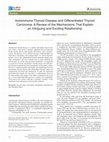
World Journal of Oncology, Jan 31, 2024
Autoimmune thyroid disease is a complex and highly frequent disease, where a wide variety of gene... more Autoimmune thyroid disease is a complex and highly frequent disease, where a wide variety of genetic, epigenetic and environmental factors (among others) come together and interact, and is characterized by the presence of two clinical outcomes: hypothyroidism (in Hashimoto's thyroiditis) and hyperthyroidism (in Graves-Basedow disease). For its part, differentiated thyroid carcinoma (mainly papillary carcinoma) is the most common type of cancer affecting the thyroid (and one of the most prevalent worldwide). An important co-occurrence between autoimmune thyroid disease and differentiated thyroid carcinoma has been documented. In this article, studies that have evaluated possible associations and relationships between autoimmune thyroid disease and differentiated thyroid cancer are systematically described and summarized. To date, the underlying mechanism that explains this association is inflammation; however, the characteristics and designs of the studies evaluated do not yet allow a causal relationship between the two entities to be established. These aspects have made it difficult to establish "causality" in the continuum of the pathogenesis between both conditions.

Diabetes, Jun 1, 2022
Patients' satisfaction is a key determinant of treatment adherence and persistence, for optim... more Patients' satisfaction is a key determinant of treatment adherence and persistence, for optimal management of T2D. ATOS, a 12-month prospective observational study conducted in Asia, Middle East, North Africa, Latin America, and Eastern Europe, showed that initiation of Gla-300 in insulin-naïve people with T2D resulted in improved glycemic control with low rates of hypoglycemia. This analysis evaluated changes in treatment satisfaction and health status among participants. Data was collected using PRO questionnaires - Diabetes Treatment Satisfaction Questionnaire status (DTSQs) and change versions (DTSQc) , EuroQoL 5-dimension scale version 3L (EQ-5D-3L) at baseline, Month 3, 6 and 12. Overall, 3931 participants completed the questionnaires. Mean ±SD age was 57.5 ±10.6 years, duration of diabetes was 10.1 ±6.2 years and baseline HbA1c was 9.3 ±1.0 %. Treatment satisfaction improved over time (DTSQs score of 21.7 at baseline to 29.8 and 31.3 at Month 6 and 12, respectively) and perceived frequency of hyperglycemia decreased over 12 months. DTSQc results were aligned with DTSQs. EQ-5D-3L results showed that proportion of people with better health status increased over time (Table) . Results showed that initiating Gla-300 in insulin-naïve people with T2D across multiple geographic regions improved treatment satisfaction and health status. Disclosure N.Khan: None. G.R.Galstyan: n/a. A.Tirosh: Advisory Panel; Abbott Diagnostics, AstraZeneca, Boehringer Ingelheim International GmbH, Merck & Co., Inc., Novo Nordisk, Sanofi, Consultant; Bayer AG, DreaMed Diabetes, Ltd., Research Support; Medtronic, Speaker's Bureau; Eli Lilly and Company. A.Bhansali: None. H.Vargas-uricoechea: Advisory Panel; Sanofi, Speaker's Bureau; Abbott. S.B.Harris: Consultant; Abbott, AstraZeneca, Eli Lilly and Company, Novo Nordisk, Sanofi, Other Relationship; Abbott, AstraZeneca, Bayer Inc., Dexcom, Eli Lilly and Company, HLS Therapeutics, Janssen Pharmaceuticals, Inc., Novo Nordisk, Sanofi, Research Support; Applied Therapeutics Inc., AstraZeneca, Canadian Institutes of Health Research, Juvenile Diabetes Research Foundation (JDRF) , Novo Nordisk, Sanofi, The Lawson Foundation. A.Roborel de climens: Employee; IQVIA Inc., Sanofi. M.N.Mabunay: Employee; Sanofi. M.Coudert: Employee; Sanofi. V.Pilorget: None. Funding Sanofi
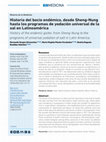
Ces Medicina, 2018
La historia del descubrimiento del yodo y la importancia que ha tenido sobre la salud ha sido apa... more La historia del descubrimiento del yodo y la importancia que ha tenido sobre la salud ha sido apasionante. Desde las descripciones realizadas siglos atrás, en las que se consideraba al bocio como una consecuencia de la ingesta de agua, considerar su aparición desde una perspectiva "supersticiosa", hasta establecer que su presencia era una característica de "adorno y belleza" para quienes lo padecían, mucho se ha escrito respecto a la deficiencia y al exceso de yodo en la población. Desde el momento en que Bernard Courtois descubre el yodo en 1811, las indicaciones sobre su utilidad en algunas enfermedades se extendieron casi sistemáticamente. Entre estas condiciones en salud se destacaron las infecciosas, neurológicas, reumatológicas, respiratorias, endocrinológicas, entre otras. En esta revisión abordamos los aspectos históricos más relevantes del yodo, y cómo éste se ha asociado con el desarrollo físico, social, demográfico y mental de la humanidad desde tiempos inmemoriales.
Cells, Mar 16, 2023
This article is an open access article distributed under the terms and conditions of the Creative... more This article is an open access article distributed under the terms and conditions of the Creative Commons Attribution (CC BY

Review of Diabetic Studies
In type 2 diabetes, therapeutic failure to the oral anti diabetics is frequent, the use of scheme... more In type 2 diabetes, therapeutic failure to the oral anti diabetics is frequent, the use of schemes with basal insulin or with multiple doses of insulin (basal insulin and short-acting insulins) are a widely accepted way to intensify therapy. The use of GLP-1 receptor agonists is another intensification strategy. The fixedratio combinations with molecules such as insulin degludec + liraglutide, and insulin glargine + lixisenatide have proven useful in intensifying treatment of individuals with type 2 diabetes. The purpose of this review was to evaluate and analyze the results of pivotal studies with both fixed-ratio combinations in individuals with type 2 diabetes, finding that, they are capable of achieving better glycemic control when compared with each of its components separately (with a lower risk of hypoglycemia vs basal insulin and lower risk of gastrointestinal adverse effects vs GLP-1 receptor agonists) in various clinical scenarios, especially in individuals who do not achi...
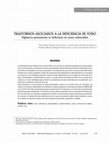
DOAJ (DOAJ: Directory of Open Access Journals), Apr 1, 2012
Iodine Deficiency Disorders (IDD) constitute a major public health problem in current world, espe... more Iodine Deficiency Disorders (IDD) constitute a major public health problem in current world, especially in children and pregnant women. These conditions frustrate socioeconomic development in those areas affected by them; people living in iodine-deficient areas are always going to be exposed to the consequences arising from this deficiency, including increased perinatal mortality, mental retardation, alterations in the synthesis of thyroid hormones, hypothyroidism, hyperthyroidism and goiter. The best way to assess IDD is through urinary iodine measurement, and the best strategy to reduce its prevalence is through universal salt iodization. We undertook a systematic review of medical literature contained in two major databases-MEDLINE and LILACS-in order to obtain a worldwide and local State-of-the Art knowledge of this problem. We found 723 papers, choosing initially 114 of them after abstracts review. Finally, only 60 of them were thoroughly reviewed. We found that IDD is an underestimated diagnosis in Colombia, the actual problem and iodine status of the population are not known. Thus, it is necessary to carry out new studies, since this preventable, predictable and treatable health problem is disregarded by politicians.
Current Problems in Cardiology, Jul 1, 2023

Endocrine, metabolic & immune disorders, May 1, 2023
Background: The population prevalence of functional alterations and thyroid autoimmunity is high,... more Background: The population prevalence of functional alterations and thyroid autoimmunity is high, and numerous genetic and environmental aspects have been described as triggering factors. Objectives: The objective of this study was to determine the prevalence of functional alterations and thyroid autoimmunity in an urban population of Colombia. Materials and methods: It is a cross-sectional, population-based study (n= 9,638) conducted on an urban population of Popayán-Cauca-Colombia between February 5th, 2018, to December 11th, 2021. The variables evaluated were thyrotropin (TSH), free T4 (FT4), and anti-thyroid antibodies (thyroid peroxidase antibodies: TPOAb, and thyroglobulin antibodies: TgAb). Results: TSH in men was significantly higher than in women. No differences were observed in the values of FT4, TPOAb, and TgAb (according to sex). The prevalence of normal thyroid function and subclinical hypothyroidism was significantly higher in men. The positivity of TPOAb and TgAb was 22.3% and 19.2%, respectively. TSH levels increased with age (both in men and in women). In participants with normal FT4 and negative TPOAb, the TSH was significantly higher. TSH was significantly higher in TPOAb-positive individuals and among those with TPOAb and TgAb positives, as well as in women with positive TPOAb and men with positive TPOAb and TgAb. Conclusion: In an urban population of Colombia, TSH was found to be higher than in populations of other geographical areas, especially in older individuals and in the presence of positive anti-thyroid antibodies, a high prevalence of functional alterations and thyroid autoimmunity was also found. These findings can be explained by excess iodine consumption and some environmental factors.
Antibodies, Jul 22, 2023
This article is an open access article distributed under the terms and conditions of the Creative... more This article is an open access article distributed under the terms and conditions of the Creative Commons Attribution (CC BY
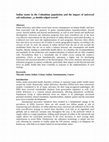
Iodine deficiency and iodine excess have severe consequences on human health, and have been assoc... more Iodine deficiency and iodine excess have severe consequences on human health, and have been associated with the presence of goiter, hypothyroidism, hyperthyroidism, thyroid cancer, thyroid nodules and thyroid autoimmunity, as well as poor mental and intellectual development. Universal salt iodization programs have been considered one of the most cost-effective interventions for the prevention of iodine deficiency-associated disorders, as evidenced over time since the implementation of such programs. However, these efforts have also led to an excessive use of iodine in certain geographical regions, according to the overuse of salt. As such, the amount of iodine derived from the use of salt exceeds the established limits that are set to strike a balance between salt consumption and health benefits, thereby leading to undesirable health effects. In Colombia, the recommendations and standards for the production and commercialization of iodized salt are fully complied with. Nevertheless, there is a remarkable rate of iodine excess among the country's population, which, at least hypothetically, represents a higher risk for developing functional and structural disorders of the thyroid gland. This review analyzes universal salt iodization programs in nations worldwide, particularly their impact on the thyroid and with focus on public health data from Colombia in response to the implementation of such strategy.
Revista Colombiana de Endocrinología, Diabetes & Metabolismo, Jun 14, 2021
COLOMBIANA de Endocrinología & ocrino crin Diabetes Metabolismo ARTÍCULO DE REVISIÓN Epidemiologí... more COLOMBIANA de Endocrinología & ocrino crin Diabetes Metabolismo ARTÍCULO DE REVISIÓN Epidemiología del hipotiroidismo en Colombia ¿en qué estamos y qué sabemos al respecto? Epidemiology of hypothyroidism in Colombia, what are we doing and what do we know about it
Revista Colombiana de Endocrinología, Diabetes & Metabolismo, Apr 24, 2020
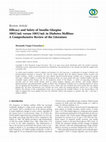
Journal of diabetes research, 2018
To achieve good metabolic control in diabetes and maintain it in the long term, a combination of ... more To achieve good metabolic control in diabetes and maintain it in the long term, a combination of changes in lifestyle and pharmacological treatment is necessary. The need for insulin depends upon the balance between insulin secretion and insulin resistance. Insulin is considered the most effective glucose-lowering therapy available and is required by people with type 1 diabetes mellitus to control their blood glucose levels; yet, many people with type 2 diabetes mellitus will also eventually require insulin therapy, due to the progressive nature of the disease. A variety of long-acting insulins is currently used for basal insulin therapy (such as insulin glargine, degludec, and detemir), each having sufficient pharmacodynamic and pharmacokinetic profiles to afford lower intrapatient variability and an extended duration of action. The new glargine-300 formulation was developed to have a flatter and more extended time-action profile than the original glargine-100, and these characteristics may translate into more stable and sustained glycemic control over a 24 h dosing interval. The objective of this comprehensive review was to summarize the available evidence on the clinical efficacy and safety of glargine-300 versus glargine-100 from the EDITION clinical trial program, in patients with type 1 and type 2 diabetes mellitus.
Revista Colombiana de Endocrinología, Diabetes & Metabolismo, Jun 14, 2021

Diabetes, Jun 1, 2020
ATOS is a prospective, 12-month, observational study assessing real-world effectiveness of the se... more ATOS is a prospective, 12-month, observational study assessing real-world effectiveness of the second-generation basal insulin analog Gla-300 in emerging markets. Insulin-naïve adults (≥18 years) with T2DM, HbA1c >7-≤11 % and previously treated with ≥1 oral antihyperglycemic drug were recruited in 18 countries. An interim analysis was undertaken when ≥50% of participants had 6-months’ follow-up data (cut-off July 1, 2019); this included 4527 eligible patients (Eastern Europe: 1748; Egypt: 214; India: 1269; Latin America and Caribbean: 317; Western Asia: 882; Southeast Asia: 46; Taiwan: 51). Mean (SD) age was 57.2 (10.8) years, BMI was 29.4 (5.3) kg/m2, and duration of diabetes was 10.2 (6.2) years; 48.4% were male. Physician-set individualized HbA1c (%) goals at baseline were <7: 13.7%; 7-<7.5: 70.3%; 7.5-<8: 11.9%; ≥8: 4.2%. The proportion of evaluable patients achieving HbA1c goal at Month 6 (primary outcome) was 25.1% (95% CI: 23.6 to 26.6); HbA1c decreases are shown in Table. Hypoglycemia incidence was low (<2%). Treatment-emergent adverse events (TEAEs) were reported in 230 (5.0%) patients, with 47 (1.0%) serious TEAEs (included population). ATOS showed high baseline HbA1c, suggesting delayed insulin initiation; introduction of Gla-300 led to marked improvements in HbA1c with a good safety profile in a real-world setting. Disclosure G.R. Galstyan: None. A. Bhansali: None. H. Vargas-Uricoechea: Speaker’s Bureau; Self; Sanofi-Aventis. A. Tirosh: Advisory Panel; Self; Novo Nordisk Inc., Sanofi. G. Sun: None. M. Naqvi: Employee; Self; Sanofi. V. Pilorget: Employee; Self; Sanofi. M. Coudert: Employee; Self; Roche Pharma, Sanofi-Aventis. D. Cherkasov: None. N. Khan: None. Funding Sanofi (ATOS/NCT03703869)
Nutrients, May 18, 2023
This article is an open access article distributed under the terms and conditions of the Creative... more This article is an open access article distributed under the terms and conditions of the Creative Commons Attribution (CC BY
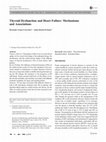
Current Heart Failure Reports, Feb 1, 2017
Purpose of Review The purpose of this review is to provide an update on the current knowledge of ... more Purpose of Review The purpose of this review is to provide an update on the current knowledge of the pathophysiology, the mechanisms, and the cardiovascular impact of the different stages of thyroid dysfunction (TD) in heart failure (HF) patients. Recent Finding The influence of thyroid hormones (THs) on the cardiovascular system involves the regulation of key processes related to maintenance of cardiac function; however, there are no long-term studies available showing that intervening the TD changes the incidence or the prognosis in HF individuals. Future research shall focus on the effects of cardiovascular morbidity and mortality associated with different treatment modalities for hyper and hypothyroidism. Summary TD has been associated with different clinical results in HF individuals; treatment with THs in patients with hypothyroidism improves cardiovascular risk factors, but the effect on cardiovascular events has not been assessed in randomized, controlled trials.
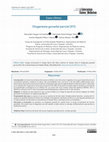
Revista Colombiana de Endocrinología, Diabetes & Metabolismo, Jan 11, 2022
Introducción: los trastornos del desarrollo sexual se definen como afecciones congénitas en las q... more Introducción: los trastornos del desarrollo sexual se definen como afecciones congénitas en las que el desarrollo del sexo cromosómico gonadal o anatómico es atípico. Son anormalidades raras, ocurren en 1 de cada 1000 a 4500 nacidos vivos. Dentro de las causas más comunes se encuentran: la hiperplasia suprarrenal congénita debido a la deficiencia de 21-hidroxilasa en un individuo XX, mosaicismos como el que involucra el 45, X/46, XY que tiene un amplio espectro fenotípico y el síndrome de insensibilidad a andrógenos en un individuo XY. Las causas más raras incluyen mutaciones genéticas (NR5A1, WT1 o MAP3K1), deficiencia de 17-beta-hidroxiesteroide deshidrogenasa y deficiencia de 5-alfa reductasa. Objetivo: el objetivo de este reporte de caso, es hacer énfasis en el riesgo de aparición de tumores malignos de células germinales en pacientes con disgenesia gonadal XY. Presentación del caso: se reporta el caso de un paciente de 24 años edad, fenotípicamente femenino, cariotipo 46 XY, ausencia de genitales femeninos internos por hallazgos tomográficos y testículos atróficos en canal inguinal (extraídos por vía laparoscópica). Se describen las características al examen físico, el enfoque clínico y el terapéutico. Discusión y conclusión: los pacientes con disgenesia gonadal XY, pueden tener un riesgo incrementado de tumores gonadales. Para poder hacer el diagnóstico de esta entidad, se debe realizar un abordaje multidisciplinario que permita su clasificación exacta.










Uploads
Papers by hernando vargas-uricoechea